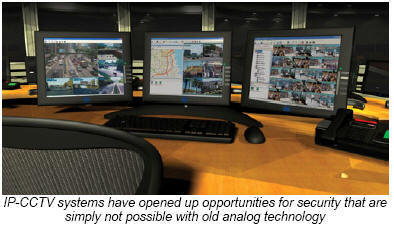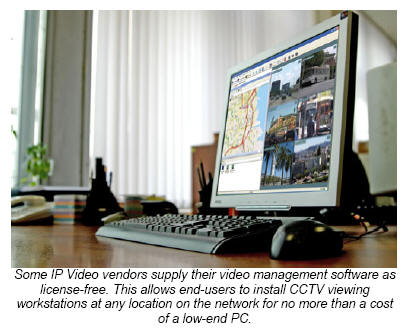April 2008
![]()
AutomatedBuildings.com
[an error occurred while processing this directive]
(Click Message to Learn More)
April 2008 |
[an error occurred while processing this directive] |
|
|
Barry Keepence, |
 Barry
Keepence, IndigoVision’s CTO, introduces the concept of Mega Video Solutions for
CCTV surveillance and describes the key elements in their design.
Barry
Keepence, IndigoVision’s CTO, introduces the concept of Mega Video Solutions for
CCTV surveillance and describes the key elements in their design.
IP-CCTV systems are not just a cheaper and more flexible alternative to traditional analog systems but they have opened up new opportunities for security that are simply not possible with the old technology. It is changing the way the security industry implements CCTV surveillance and has spawned a new concept – Mega Video Solutions.
|
|
|
|
|
|
|
|
|
|
|
|
|
|
|
|
|
|
|
|
|
[an error occurred while processing this directive] |
Mega Video can be defined as large scale virtual matrix CCTV systems with 1000+ cameras, 200+ monitors, 50+ operators, 100+ NVRs with one petabyte+ of storage, that are continuously displaying and recording high-quality video across IP networks that span entire plants, communities and countries.
This may be a new concept but real Mega Video projects have been deployed and running reliably for a number of years, such as the Brussels Airport 1000+ camera system, which has been IP-based since 2001.
When comparing the architecture of Mega Video solutions to traditional analog CCTV systems it soon becomes clear why certain large-scale, wide-area surveillance applications are either not possible or are too expensive to implement with analog technology. The IP network combined with video management software becomes the video switching matrix or the virtual matrix as it is commonly known, replacing the centralized switching hardware of analog/DVR based systems. The nearest video monitor or workstation is therefore the nearest IP network connection and as the network is typically everywhere in a building so the monitors and workstations can be too. Total flexibility with video display options are possible due to the distributed nature of Mega Video solutions.
Replacing Video Monitors with PC Workstations
 PC
workstations are now replacing traditional video monitors as PC technology has
become increasingly more reliable and cheaper. Some IP Video vendors supply
their video management software as license-free. This allows end-users to
install CCTV viewing workstations at any location on the network for no more
than the cost of a PC. This compares very well with the huge cost of installing
a large analog video matrix and associated video walls.
PC
workstations are now replacing traditional video monitors as PC technology has
become increasingly more reliable and cheaper. Some IP Video vendors supply
their video management software as license-free. This allows end-users to
install CCTV viewing workstations at any location on the network for no more
than the cost of a PC. This compares very well with the huge cost of installing
a large analog video matrix and associated video walls.
PCs are also very good at replacing monitors. Simply run them in full screen mode and lock the keyboard away, and with the appropriate password an expert user can access the full features of the software e.g. playback of recorded video, which is not possible with analog systems. Some large sites have now deployed IP-CCTV systems that are 100% PC based with no analog monitors at all.
This distributed architecture works well because the cost of the video management software is either low or free. If the cost of the end user software is high, then this leads integrators to build centralized architectures - just the same as analog!
Death of the Video Wall
The video wall has become a common sight in CCTV control rooms as it was the only way to view large amounts of video from traditional analog surveillance systems. The ‘classic’ CCTV model has a large analog matrix in one room and a ‘CCTV viewing room’ next door displaying the wall of monitors. With the advent of distributed IP-CCTV systems this is changing. No longer do you need to take the people to the video, but with distributed IP networked systems you take the video to the people.
When comparing the architecture of IP Video solutions to analog CCTV systems it soon becomes clear why the video wall is no longer needed. The IP network becomes the video switching matrix or the virtual matrix as it is commonly known. The nearest video monitor is therefore the nearest IP network connection and as the network is typically everywhere in a building so the monitors can be too – taking the video to the people!
Large video walls allowed many people to view the same video at the same time, IP-CCTV systems allow many people to view the same video simultaneously on the screen in front of them, whether it is live or recorded.
The storage architecture for CCTV systems can be typically categorized as either centralized or distributed.
IP Multicasting
Centralized Storage Architectures
One of the key features for transmitting video over long distances and to many users without huge impact on the network bandwidth is multicasting. IP Multicasting is an extremely powerful feature of IP networks that allows CCTV video footage from the same camera to be efficiently viewed and recorded by multiple CCTV operators at the same time. Multicast networks make sure the video stream only goes to the people who need to see it, thereby reducing the overall bandwidth. IP Multicasting requires compatible network switches and routers; however, multicasting capabilities are now available on entry-level devices.
Designing Mega Video Solutions
Conceptually it’s easy to see the benefits of a distributed Mega Video IP network based system. However, many people say that the network and storage requirements are just too demanding for these systems to be implemented. Apart from the fact that such systems have been deployed and have been reliably working for a number of years, Mega Video systems can be designed as long as these three cornerstones are implemented correctly:
High video compression without losing quality
Network design
Storage design
[an error occurred while processing this directive] Compression: The key to reducing bandwidth and storage requirements is choosing the best compression technology available. There are a number of compression standards currently employed in IP Video systems. H.264 is the latest official video compression standard, which follows on from the highly successful MPEG-2 and MPEG-4 video standards and offers improvements in both video quality and compression. The most significant benefit for IP Video systems is the ability to deliver the same high-quality, low latency, digital video with savings of between 25% and 50% on bandwidth and therefore on the storage requirements. By selecting a system based on H.264 further savings on storage can be achieved. Even though H.264 is more efficient than MPEG-4, there are still differences between vendors’ implementation of the standard and hence the amount of bandwidth and storage required.
Network Design: It is important to understand the data paths through the network. Almost all video is never looked at; it goes straight from the camera transmitter/receiver (codec) to the Network Video Recorders (NVRs). The two points of maximum data bandwidth are at the NVR and at the viewing stations. The key to network topology is therefore to group the transmitters and NVRs into ‘nodes’. This configuration also produces a fault-tolerant network where a single network cable failure can only take out a small part of the network.
Storage Design: The two key factors here are NVR performance and storage architecture.
The amount of data coming from the cameras to the NVRs is huge and continuous. The amount of data coming from the NVR to the users is very low and periodic. The workload is constant, i.e. the rate of writing data to the disk is constantly high, not in bursts as with typical IT applications.
The processing overhead for writing and reading the video streams to disk is therefore an important factor in the overall performance of the NVR. There can be a considerable difference in this overhead between different vendors of NVR software. Software which can minimize this processing will be able to handle many more camera streams per NVR. The best NVR server software on the market has such a low CPU loading that 500 camera streams can be recorded on the lowest specification server PC.
For large Mega Video systems the storage architecture needs to be distributed as outlined in Network Design above, with small NVRs distributed across the network. If PC based NVR servers were used, then many separate PCs would be required each with their own local attached storage, which comes at a significant cost. An alternative would be to use dedicated, standalone NVR units which have the processing hardware and storage in a single compact unit. These are considerably less expensive than a PC server and equivalent storage. These standalone robust hardware units can have redundant power supplies and network connections, RAID configurations and hot-swappable drives to provide a resilient and reliable storage solution. For example the IP Video surveillance system on Skytrain, the world’s largest automated light rapid transit system in Vancouver, with 30 stations along 49km of track, includes 63 standalone NVRs with a total storage capacity in excess of 60Tb, recording 897 cameras.
Summary
For large-scale CCTV applications analog technology is no longer a match for IP Video technology. The new breed of Mega Video systems are providing infrastructure projects with a CCTV solution that was simply not technically possible or cost effective with analog equipment. The benefits to end users are significant and the implementation and reliability of Mega Video solutions are already field proven – making it no longer just a concept!
[an error occurred while processing this directive]
[Click Banner To Learn More]
[Home Page] [The Automator] [About] [Subscribe ] [Contact Us]